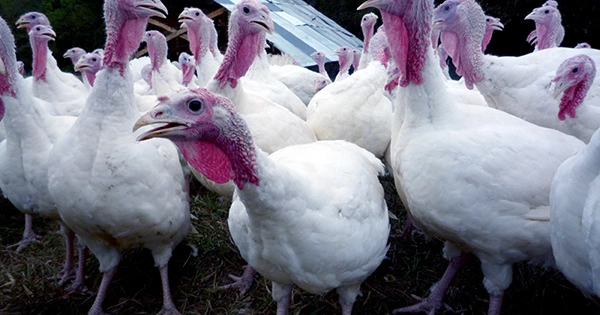More birds have died as a result of an ongoing outbreak of a deadly form of bird flu in the United States than ever before.
According to data from the Agriculture Department, also known as highly pathogenic avian influenza, the virus has caused the deaths of 50.54 million domestic birds in the nation this year. In that number, you can see chickens, ducks, and turkeys from backyard flocks, petting zoos, and industrial poultry farms.
According to Reuters, the countertops the previous record of 50.5 million dead birds from a 2015 outbreak. Separate USDA data reveals that wild birds have at least 3,700 confirmed cases.
A barn with turkeys on a farm for poultry.
On farms, some poultry perishes from the flu directly, but in other instances, once one poultry tests positive for the virus, farmers destroy their entire flocks to stop the virus from spreading. The “ventilation shutdown plus” method of culling, in which the airways to a barn are closed off and heat is introduced to kill the animals, has occasionally garnered criticism from animal welfare organizations.
Since 2021, the virus has ravaged Europe and North America. Bald eagles, vultures, and seabirds are just a few of the many wild birds that have been impacted globally. Following the discovery of 200 dead pelicans on a beach this month, Peru confirmed its first suspected outbreak of highly deadly avian influenza.
On November 24, pelicans were spotted on a beach in Lima, Peru, where it is thought they may have succumbed to highly deadly avian influenza.
A significant factor in the spread has been the migration of infected wild birds. Anyone who raises domestic birds is urged by health and wildlife experts to keep them separate from their wild counterparts.
Although most medical professionals do not believe that highly pathogenic avian influenza poses a significant threat to animals, an Alaskan black bear cub was put down earlier this month after being infected. The newborn cub has a weakened immune system, wildlife veterinarian Dr. Kimberlee Beckmen told the Juneau Empire newspaper.
The National Oceanic and Atmospheric Administration suspected an exceptionally high number of seal deaths were caused in part by the avian flu that spread among seals in Maine over the course of the summer.
The risk of the avian flu outbreak “to the general public” is minimal, according to the Centers for Disease Control and Prevention. However, the organization advises preventative measures for those who have prolonged contact with birds that may be contaminated, such as wearing personal protective equipment and proper cleaning hands.
The first individual in the United States to test positive for the new strain was a Colorado prisoner who was employed at a commercial farm in April, despite the fact that he was mainly asymptomatic.
















